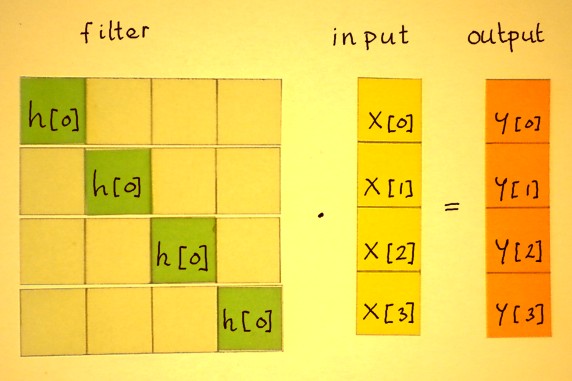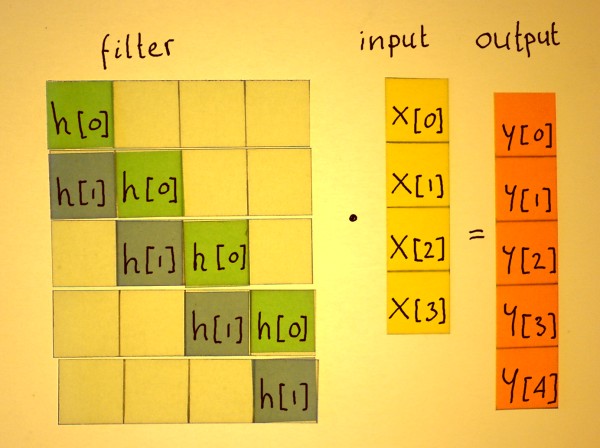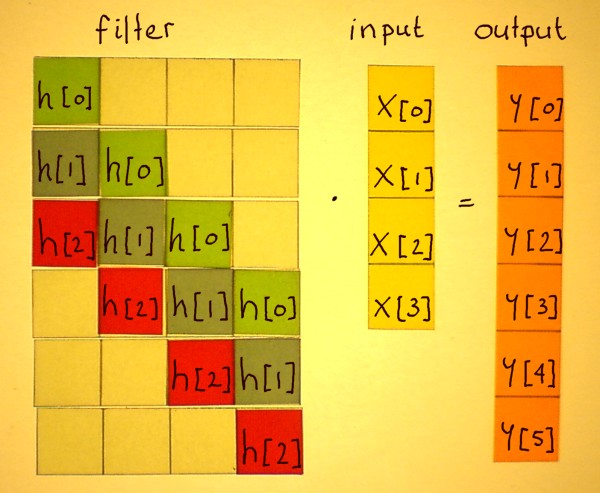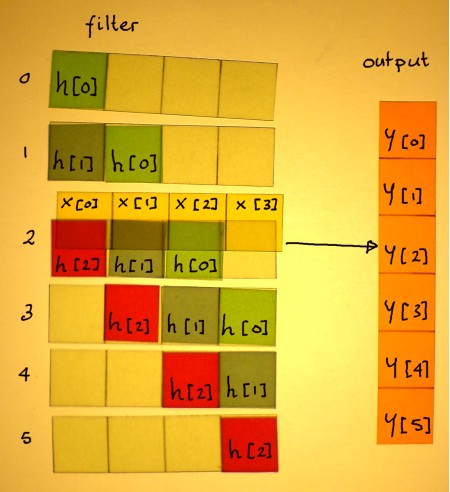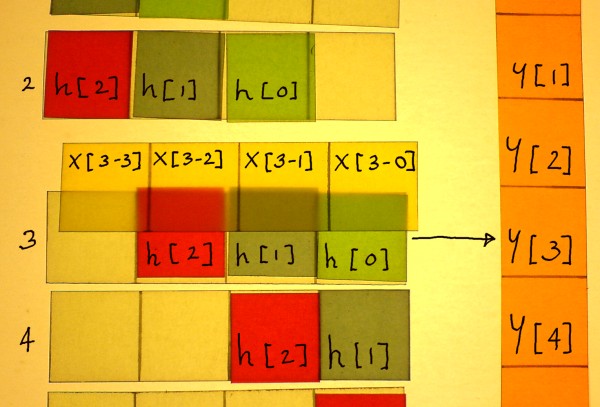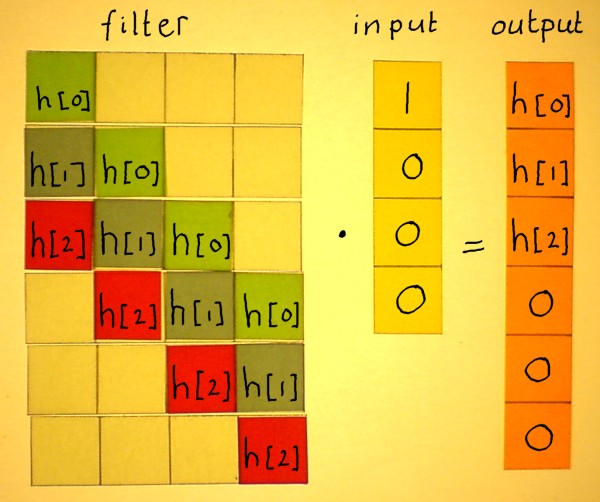Convolution
A Matrix Operation
|
From "Wavelets and Filter Banks" by
Gilbert Strang and Truong Nguyen, I learnt that convolution can be
considered a matrix operation.
Convolution can do (no
more than) amplification and attenuation of frequencies by means of
phase cancellation/reinforcement. The popular name is therefore:
filtering.
|
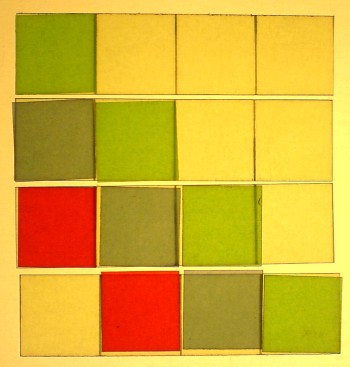
|
In convolution, three arrays of sample values appear:
an input array x[n]
an impuls response array h[n] (the 'filter')
an output array y[n]
[n] denotes a sample index number. The index can be related to time
or space if you want. The impuls response h[n] is responsible for the
amplification / attenuation. For convenience I will
call that array 'filter'. Only later on this page I can illustrate what
it means that the filter is an impulse response.
Below is the simplest of convolutions as an example to start with. A
one-sample 'filter' h[0] is on the main diagonal, which is also called
identity diagonal. The input array and output array are vectors of
equal length here. They could be streams of audio with a million or a
billion of samples as well. That would make a very big square filter
matrix, but still with only one diagonal.
Such a convolution with h[0] can only amplify or atttenuate all
frequencies at the same time. Not what we call a filter yet.
Let us next do an example with a two-sample h[n]. That can already
make a useful filter in practice. If you inspect the rows of the filter
below,
you will notice that the array h[n] appears time-reversed in the
matrix. That is a
major aspect of convolution.
As compared to the one-sample filter, an extra row in the filter
matrix, and thus in the output, is required to complete the convolution
with the two-sample filter.
One more example to see the system of it. The diagonals are
constant. All filter coefficients
h[n] have a fair share in the operation. They appear as many times as
there are input samples. There is also a rule of thumb for the output
array-length:
N[filter] + N[input] -1 = N[output]
In the example below it is: ((3+4)-1) = 6
Below, the correlation for output index y[2] is illustrated as an
example. The rows of the filter matrix are numbered, and they
correspond to the output rows. Notice that x[2] is multiplied with the
filter's identity diagonal. Furthermore, some older samples of x[n] are
used.
Fortunately webpixels cost nothing so I can afford doing lots of
pictures. Below is the correlation for y[3]. It is almost hard to
distinguish it from the preceding picture, because the operation is so
systematic. So let us try to identify the pattern of it.
Admittedly it took me quite some time to disclose the pattern in a
sensible way. But look, the index number of x[n] can be described in
terms of the y[n] and h[n] indices.
In order to write the whole thing in an algebraic formula, some
index letters will have to be renamed, unfortunately. I suggest that we
use x[m], y[m] and h[n]. Then the whole convolution can be described
efficiently in terms of the arrays:
In words: y[m] = the sum of all products h[n]*x[m-n].
Suppose the filter array is a fixed buffer and the input array is a
stream. Then it would be effective to keep older values of x[n] in a
circular buffer or (multitap) delayline. That is indeed how filters of
modest length are done. Below is the flowchart of the example filter.
One question is still not answered: why is h[n] called 'impulse
response'? Again, this can be illustrated nicely with a simple matrix
(I love them). For the input array x[n], we choose a unit puls or
impulse as it is called. In the digital domain that means: a
samplevalue
of 1 on x[0] and zero's everywhere else. Now look at the output (the
response to the impulse). It is the filter array itself! So at the
ouput
it appears in the normal time-direction....
The filter matrix implements reflections. The later reflections
(higher index numbers of h[n]) have a longer delay time. That is why
h[n] appears time-reversed in the matrix operation. The higher h[n]
indices must operate on older samples of x[n]. And older samples means:
lower index numbers.
There is a strong analogy with acoustic reflections. Imagine you do
a pulse in a reflective space, by clapping your hands once. The
response to that pulse is: the direct sound h[0], the first reflection
from a nearby surface h[1], and the second reflection from a surface
further away h[2]. These reflections will also do phase cancellation
and reinforcement, thus filtering.
The impulse response is a soundwise blueprint of a space or system.
Once you have captured it digitally, or computed an idealised impulse
response, you have your filter array.

